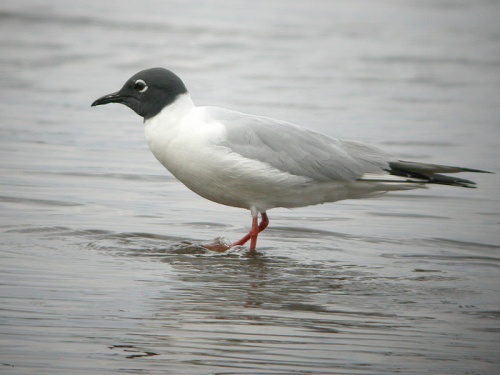- Chroicocephalus philadelphia
Larus philadelphia
Identification

Photo © by raulroa
Bolsa Chica Wetlands, Huntington Beach, California, USA, November 2007
28–30 cm (11-11¾ in)
Generally easily identified among small hooded gulls by light grey back, pink legs, small black bill, and less extensive black on primaries in flight.
Similar species
Little Gull is smaller with thinner shorter bill, slightly more extensive hood, red legs (1st winter pink), and very short primary projection.
Black-headed Gull is slightly larger with perhaps slightly lighter back, less extensive brownish hood, slightly larger red bill (in all plumages except juvenile which has pale bill), extensive black on primaries in flight, and reddish legs (1st winter has orange).
Franklin's Gull is larger with much darker back and larger bill.
Laughing Gull is much larger with much darker back and much larger bill.
Distribution
Breeds in Alaska and east across Canada to James Bay with non-breeders present in summer on north-eastern coasts.
Winters from the Great Lakes southwards and on the Atlantic coast from New England south to northwestern Caribbean. Leaves breeding grounds in late July with many gathering off Nova Scotia in late August-early September, return movement in April-May.
Vagrancy
Vagrants have been detected in the eastern and southern Caribbean to Bonaire, Curacao and Barbados.
Fairly frequent vagrant to the Western Palearctic most often recorded in the British Isles but also in Iceland and Scandinavia, the Netherlands, Belgium and France, Germany, Hungary, Iberia, Morocco and the Azores. British records (c.115) mainly in the south-west but also east to Norfolk and north to Shetland. The records are spread throughout the year and include long-staying and returning individuals and both adults and immatures.
Taxonomy
This is a monotypic species[1].
Some authorities still place this species in genus Larus.
Habitat
Breeds beside pools and swamps in tundra and taiga. Out of the breeding season found at freshwater and saline lakes, following the plough on farmland and by the sea. In coastal areas seen on sandy shores and mudflats, estuaries, harbours and on coastal lakes and lagoons.
Behaviour
Breeding
They breed near bogs or lakes in coniferous forest, nesting in conifers, or on the ground.
Diet
The diet includes insects, crustaceans and fish; they rarely scavenge.
Vocalisation
Less vocal than most gulls but when feeding utters a high nasal cheeer or chirp.
Gallery
Click images to see larger version
Nonbreeding adult
Photo © by wrexile1
Newbiggin, Northumberland, October 20061st summer bird
Photo © by bobsofpa
San Joaquin Wildlife Sanctuary, California, USA, May 2007
References
- Clements, J. F., P. C. Rasmussen, T. S. Schulenberg, M. J. Iliff, T. A. Fredericks, J. A. Gerbracht, D. Lepage, A. Spencer, S. M. Billerman, B. L. Sullivan, and C. L. Wood. 2023. The eBird/Clements checklist of Birds of the World: v2023. Downloaded from https://www.birds.cornell.edu/clementschecklist/download/
- Gill, F, D Donsker, and P Rasmussen (Eds). 2023. IOC World Bird List (v 13.2). Doi 10.14344/IOC.ML.13.2. http://www.worldbirdnames.org/
- Collins Field Guide 5th Edition
- Collins Bird Guide ISBN 0 00 219728 6
Recommended Citation
- BirdForum Opus contributors. (2025) Bonaparte's Gull. In: BirdForum, the forum for wild birds and birding. Retrieved 1 May 2025 from https://www.birdforum.net/opus/Bonaparte%27s_Gull
External Links
GSearch checked for 2020 platform.1







